Part One: Jamonisimo, Abac, El Celler de Can Roca
Any account of restaurant life in Barcelona and its environs must begin with El Bulli. So I confess that during my six days in Catalonia I did not eat at El Bulli. Perhaps it is just as well because El Bulli has become at least as much of a shrine as a restaurant. (I cannot comment on the shape of Chef Adraia’s cuisine or the validity of the religion for which he is the godhead). However, attempting to acquire a reservation eleven months prior to the date of our visit proved unsuccessful and no amount of waiting, pleading, or networking gained a table. This stands in contrast to the platonic El Celler de Can Roca (a Michelin three star restaurant), which still had open tables during the lunch that I dined in Girona. Could El Bulli be eleven months more fantastic than Can Roca? I can’t judge, but must speculate that at least some of those months may be attributable to our celebrity culture.
Still, my week in Barcelona was not without glories: Jamonisimo (*), Abac (***), El Celler de Can Roca (****), Cinc Sentits (****), Comerç 24 (**), Botafumeiro (*), Alkimia (****), and Drolma (**). There were some disappointments (Comerç 24 most dramatically), but there was not a bad meal. How many cities might one say that of? Paris? New Orleans once upon a time? New York, if one is careful?
Arriving in Barcelona in late morning, I set my sights on what I imagined would be a light lunch: a smidgen of Spanish ham: Iberian jamon. Near my hotel was a modernist and elegent jamoniserie (my term), Jamonisimo. Primarily a purveyor of dry cured ham, Jamonisimo has a few tables in back where they serve their wares. Perhaps it was due to our uncertain communication, but when I ordered Iberian ham in three textures (the parts of the leg from which they derived was shared for my edification), the plate was larger than I imagined (and could have easily satisfied several ravenous beach volleyball squads). But what an introduction to Catalonia! With dinner served at 9:00, pigging out at lunch was not a tragedy. The slices and chunks had subtly different tastes, density, and moisture, and the experience was distinctively different from an American country ham: richer and less salty. As I chomped, I couldn’t avoid thinking of Bill Buford’s Dante-quoting butcher, wondering whether such a butcher stood behind Jamonisimo.
Dinner brought me to Abac where an al fresco dinner was filled with pleasure, even if I could not claim that the meal was transcendent. Still outdoor dining in a splendid little garden on a warm late summer Catalan night provided hours to be treasured, and a worthy comparison for other dinners. I remember particularly one of the opening snacks: crispy veal, tasting for all the world like a meaty potato crisp.
Equally appealing was an appetizer that consisted of a lovely textured soup, part foam, part mousse, part liquid. An emerald vichyssoise, combined with scallions, leeks, and asparagus. This was a libation that coolly contrasted with the still summer evening. Perfectly made, perfectly enjoyable. However much work went into its construction, its elegant simplicity was a diner’s joy.
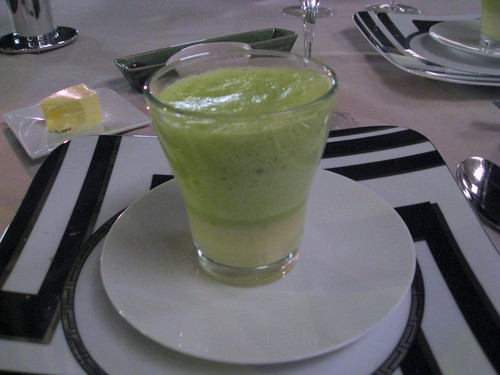
I also enjoyed the sashimi quality tuna, raw on the inside, with a cherry gelee and sangria sauce. The tang of the fruit complimented the fish well. While not a unique presentation or set of flavors, it was successful. Similar was the pigeon with cardamom and onion, served with a well-composed salad. The cardamom might have been pushed up a notch, as the flavor was muted, but the game was luscious.

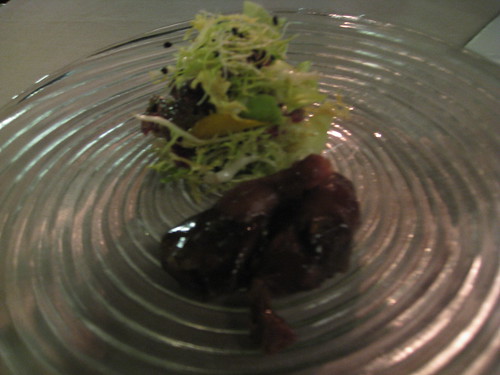
Of the desserts, I particularly enjoyed the sculptural passion fruit with cream sauce and spun sugar. As is typical for Abac the flavor combinations are not astonishing, but the dishes reveal real sophistication for the mid-range of diners. I was not stunned, but it was a fine way to share a first evening in B-lona.
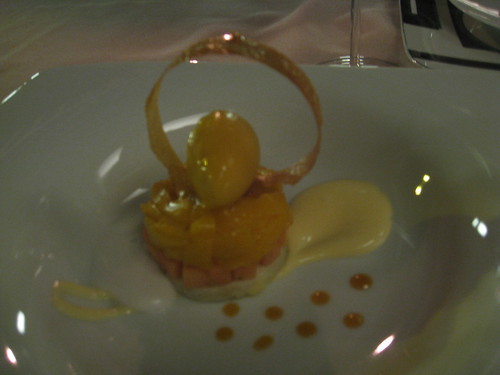
In contrast, platonic is the word for my visit to El Celler de Can Roca, a sleek and airy restaurant on the outskirts of Girona set in a peaceful modernist garden setting. One of the effects of having El Bulli down the road is that there is no need to compete in startling excess. Can Roca offers poetry to E.B.’s cracked science. But through it all the effects of a cuisine agape are evident. El Celler de Can Roca reveals a distinctive style, a style that owes much to sous vide techniques, capturing a density and purity of taste. However, sous vide does not scream at a diner. Not told that one’s meat was cooked sous vide, the marks of the process are hard to pinpoint, other than that the dish seems remarkable tender and flavorful, exquisite in taste and texture, but without blaring headlines.
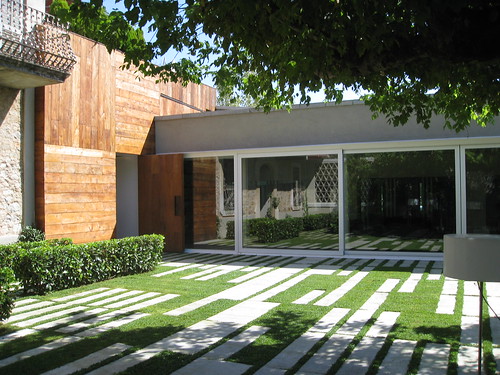
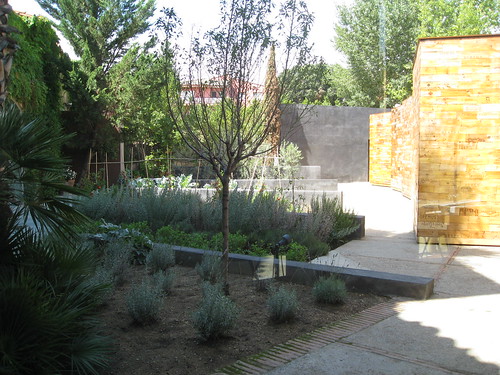
At a restaurant of the quality of Can Roca, anything less than the tasting menu would be a sin: and I rarely sin at table. My tasting notes are, rather redundantly, filled with the word “amazing.” Chef Joan Roca is in confident control (along with his brothers, Josep, the Sommelier, and Jordi, the Pastisser).
Still the less dramatic “snacks” make the rest of the meal look astonishing in comparison. Weakest was baby carrots with orange, stick and sweet, but not clever. Better was a nicely prepared lavender crisp and the lovely bitter cherries with campari and anchovies.
But it was the second opening course that persuaded. This was among the most experimental presentations of the luncheon. Actually it consisted of a trio of courses: ‘Sferificacion’ of Cockles with Guava Juice and Campari (Sferificacion is an El Bulli-derived technique of controlling the gelification of a liquid to provide desired shapes), a skin of cucumber soup with popcorn made of garlic soup, and a luxuriant and very Spanish pigeon bombon with Bristol Cream sherry. The last, appearing to be a cross between a truffle and a mallomar, is an exquisite game pie in a single bite. It heralds autumn. The cucumber soup is perfect in its edgy elegance, rich with herbal flavor. I loved the cockles, particularly because of the bitter and cocky campari-reprise. Although there didn’t seem to be a strong connection among these three starters, eating them in sequence was delight.
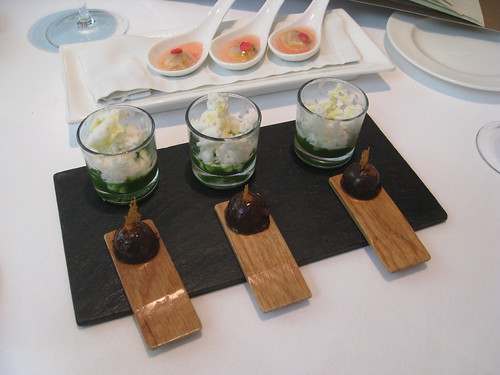
Oysters with with Agusti Torello cava, apple compote, ginger, pineapple, lemon confit, and spices was modernist salt-spray fruit salad, coordinated to emphasize the briny taste of the mollusk. Here was complex deliciousness that was both clean and oceanic.
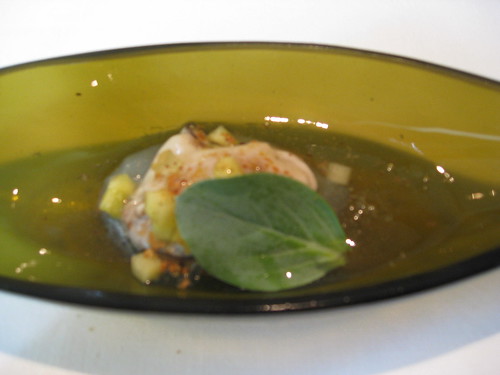
Melon with cured ham was a trompe l’oeil triumph: an extrusion of melon with fine Iberian ham. Conceptually this was cute, but the heart of the plate was the superb cured ham. One could almost taste the acorns on which the pig once feasted. No lipstick on this porker, but it was still a pig.
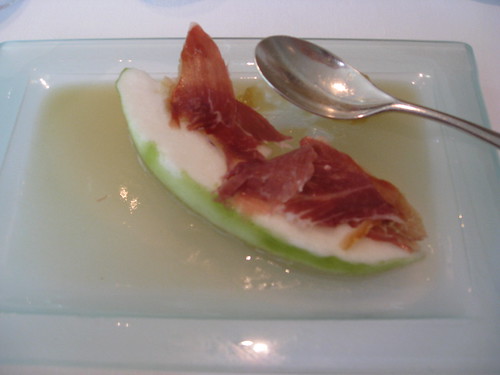
This was followed by a magnificently imagined taste festival. Not experimental, it represented modern cuisine’s desire to explore the boundaries of taste: Cherry soup with shrimp and a scoop of ginger ice cream mixed tart and rich, warm and cold, with every element skillfully prepared. This was an astonishing dish. From now on I will serve my shrimp cocktail with jam.
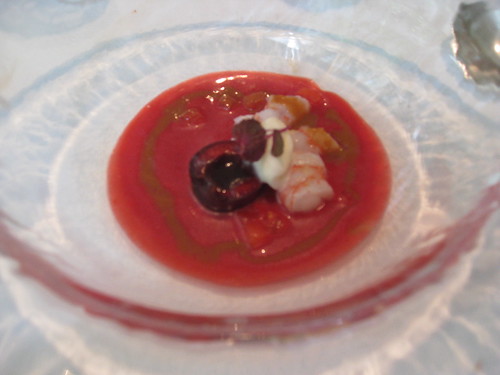
Green olive parmentier with foamy tuna sauce was another experiment in taste: an egg-like lump, playing on the imaginings of olive and potato: a tuna salad from the far future. Perhaps the taste did not compare with the cherry soup, but it combined tastes and textures with élan.
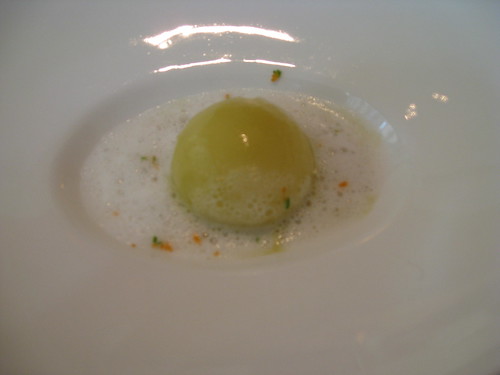
The following pair of dishes – amontillado-steamed king prawn and smoked summer-truffle soufflé – depended on splendid ingredients, impeccably cooked. Neither had sharp strokes of contrasting tastes, but their subtleties were delicious. The truffle soufflé was so sensuous that it deserved to be eaten in bed.

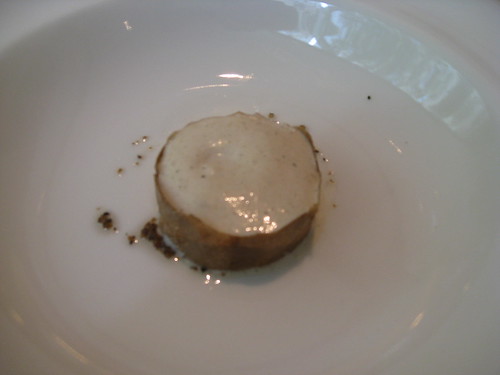
Sole with sea fennel and charcoal-grilled leeks bowed to classic cuisine (sous-vide classic, of course). Many modern chefs seem at sea with sauce, but not Chef Roca. Silken, foamy sauce with fish cooked by God’s hand, its elegance can not go unremarked. This plate reminds us why so many diners loved – and love – classic cuisine, even as lightened with low cooking and roux-free saucing.

Kid belly fillet with goat’s milk parmentier consisted of a rectangle of goat belly (today’s “in” body part) with perfectly crispy skin. This presentation was far more modern that the sole with just enough potato pudding and goat sauce to provide for an interactive experience. Another sumptuous dish.

Goose liver terrine with apricot compote is Chef Roca’s tribute to the foie gras wars. Foie, but not gras, it had a gaminess that foie gras can never equal, evoking the wild in ways that depend on the pungency of goose liver. This was a powerful plate. As foie gras is meat jam, Chef Roca’s foie is a treat from the hunt.
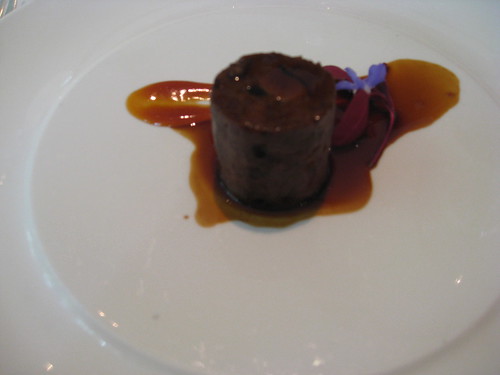
Dinner concluded with a pair of desserts. First was a decorative dish labeled “A fragrance adapted: Extreme by Bulgari (Bergamot cream, lime sorbet, tonka bean, vanilla and patchouli).” The idea seemed precious, but the dish was a decorator’s dream. Not my favorite of the afternoon, it was a pretty mix of textures, tastes, and aromas. Not knowing Extreme fragrance, I cannot tell whether it matches, but I surely would prefer Extreme on warm skin than cold glass.
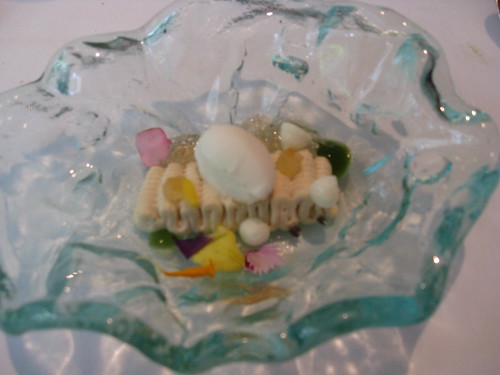
Cherries with vanilla and amaretto, draped with a clear sugar wrap, completed the cherry trilogy. I love cherries, and found this ending to be filled with smiles.
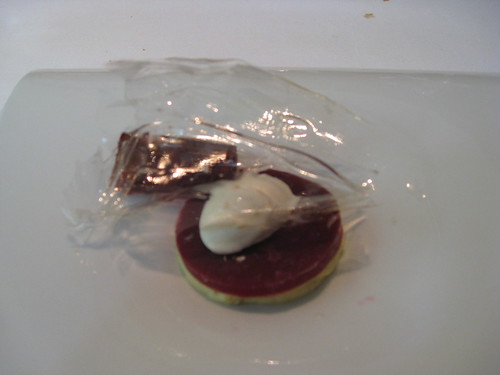
Were it not for its colleague down the road, El Celler de Can Roca would be goal of any gourmet’s pilgrimage. Bravo.
END OF PART ONE, CATALONIAN CUISINE
Jamonisimo
Provença 85 (Eixample)
Barcelona
93-439-0847
www.jamonisimo.com
Abac
Avenue del Tibidabo 1-7 (Tibidabo)
Barcelona
93-319-6600
www.abacbarcelona.com
El Celler de Can Roca
Can Sunyer 48
Girona, Spain
972-22-21-57
www.cellercanroca.com/inici.php?secc=presentacion&lang=uk

No comments:
Post a Comment